Why Professional Website Design is a Necessity Today?

In the current digital age, an online presence for any business or individual seeking visibility and growth is not a privilege, but a vital necessity.
There was a time when having a website was merely an option for #large_businesses, but today, even the smallest businesses need a digital platform to survive and compete in the market.
A #professional_website acts as your digital storefront, not only showcasing your products and services but also reflecting your #brand_identity and building #potential_customer_trust.
Professional website design allows you to reach a wider audience, improve customer interaction, and even significantly increase your sales.
Without a website, your business will virtually remain invisible in the online space.
This becomes especially important when we know that the vast majority of consumers first search the internet before purchasing or using services.
An unprofessional or outdated website not only eliminates business opportunities but can also undermine your brand’s credibility, and it is an undeniable fact that in today’s competitive world, first impressions are crucial.
Therefore, investing in professional website design is, in fact, an investment in the future of your business.
Tired of losing business opportunities due to not having a professional corporate website? Worry no more! With RasaWeb’s corporate website design services:
✅ Your brand’s credibility and professionalism will increase.
✅ You will attract more customers and sales leads.
⚡ Get a free consultation now to start!
Key Steps in Professional Website Design from Idea to Implementation
![]()
The professional website design process involves multiple interconnected stages, each playing a crucial role in the project’s ultimate success.
The first step is precise needs assessment and planning.
In this stage, the website’s objectives, target audience, required functionalities and features, as well as budget and project timeline, are defined.
This phase also includes competitor research and market analysis to ensure the final website will have a competitive advantage.
The second stage is User Interface (UI) and User Experience (UX) design.
In this section, sitemaps, wireframes, and prototypes are designed to define the visual structure, page layouts, and how users will interact with the website.
The main goal is to create a smooth, enjoyable, and intuitive user experience.
After the initial designs are approved, we move into the development and coding phase.
In this stage, visual designs are converted into HTML, CSS, JavaScript code, and server-side programming languages.
This section requires high technical expertise for the website to function correctly and be robust in terms of security.
Next, comprehensive testing and experimentation of the website takes place.
This stage involves checking the website’s performance across different browsers, mobile devices, and identifying and fixing any errors or bugs.
Ensuring high loading speed and website responsiveness (Responsive Design) is crucial at this stage.
Finally, after final approval, the website is launched and becomes publicly accessible.
But the work doesn’t end there; after launch, monitoring website performance, updating content and software, as well as SEO optimization for greater visibility, are of paramount importance.
These steps guarantee professional website design and its optimal long-term performance.
The Importance of User Experience (UX) and User Interface (UI) in Professional Website Design
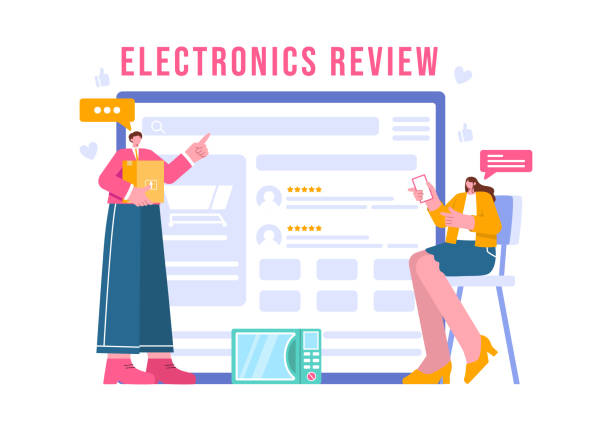
At the heart of every professional website design are the concepts of User Experience (UX) and User Interface (UI).
These two concepts are often confused, but they are actually complementary and both are essential for a website’s success.
UX refers to the user’s overall experience when interacting with your website. This includes ease of use, logical navigation, and the feeling the user gets from your website.
Excellent UX ensures users can easily find what they are looking for, enjoy the website, and return to it.
On the other hand, UI relates to the visual appearance of the website, including layout, colors, fonts, buttons, and images. Good UI makes the website beautiful, attractive, and readable.
Without beautiful UI, even the best UX cannot be fully appreciated; and without strong UX, even the most beautiful UI will disappoint users.
Imagine you have a very beautiful car (excellent UI), but it’s very difficult and complicated to drive (poor UX).
Or vice versa, you have a very comfortable and efficient car (excellent UX), but its appearance is very unsightly (poor UI).
For a successful website, both must be in perfect harmony.
A professional website design always considers these two aspects integrally.
Focusing on UX and UI not only reduces the Bounce Rate but also increases the Conversion Rate and leads to greater customer loyalty.
For this reason, when planning for professional website design, sufficient budget and time should be allocated to these two areas.
| Feature | User Experience (UX) | User Interface (UI) |
|---|---|---|
| Main Focus | User feeling, efficiency, user satisfaction | Visual appearance, interactions, style |
| Goal | Solving user problems, improving usability | Aesthetics, user guidance, visual communication |
| Work Area | User research, information architecture, analysis | Graphic design, color and font selection, animation |
| Example Elements | Site map, wireframe, user flow, usability testing | Buttons, icons, images, page layouts, themes |
| Key Question | Is the product easy and enjoyable to use? | Does the product look attractive and beautiful? |
Choosing the Right Platform for Professional Website Design

One of the crucial decisions on the path to professional website design is choosing the right platform.
This choice directly impacts the development speed, flexibility, customization capabilities, security, and maintenance cost of your website.
Generally, there are two main approaches to building a website: using Content Management Systems (CMS) like WordPress, Joomla, and Drupal, or custom coding from scratch.
WordPress is the most popular CMS in the world due to its ease of use, large user community, and thousands of free and paid themes and plugins, and is an excellent option for blogs, small corporate websites, and even medium-sized online stores.
Joomla is also a powerful and flexible CMS suitable for moderately complex projects, and Drupal is recommended for very large and complex websites with high security and performance requirements.
The main advantage of CMSs is their high speed in launching and less need for deep technical knowledge.
However, their use might create limitations for highly specific customizations, and sometimes too many plugins can affect website speed and security.
In contrast, custom coding provides complete freedom in designing and developing any specific feature you have in mind.
This approach is ideal for very unique projects with specific functional or security requirements that CMSs cannot cover.
However, it should be noted that custom coding is usually more time-consuming, more expensive, and requires a professional development team with deep programming knowledge.
Choosing the best platform depends on your goals, budget, and team resources, and should be done with great care and after consultation with professional website design specialists to ensure you have an effective and professional website.
Tired of losing customers due to poor e-commerce website design? With RasaWeb, solve this problem forever!
✅ Increase sales and conversion rates from visitors to customers
✅ Smooth and engaging user experience for your customers⚡ Get free consultation
The Role of SEO in the Visibility of a Professional Website Design

Professional website design alone does not guarantee success in the online world.
No matter how beautiful and user-friendly your website is, it’s practically useless if it’s not seen by your target audience.
This is where the role of Search Engine Optimization (SEO) becomes prominent.
SEO is a set of techniques and strategies implemented with the goal of increasing your website’s ranking in organic (non-paid) search results of search engines like Google.
When users search for keywords related to your business, the goal is for your website to appear on the first pages of results.
This means increased traffic, increased brand awareness, and ultimately, increased sales.
SEO can be divided into two main parts: On-Page SEO, which includes optimizing elements within the website such as keywords in content, page titles, meta descriptions, URL structure, image optimization, and internal links; and Off-Page SEO, which mainly relates to building quality backlinks from other websites and social media activity.
A professional website design must be compatible with SEO principles from the very beginning.
This means the website must be technically sound (high loading speed, responsiveness, clean code structure), have high-quality and relevant content, and its navigation must be easy for users and search engine crawlers.
Ignoring SEO during the professional website design phase can lead to additional costs for later corrections or reliance on paid advertisements.
Therefore, SEO is an indispensable component of a successful strategy in professional website design.
Content is King: How to Create Engaging Content?
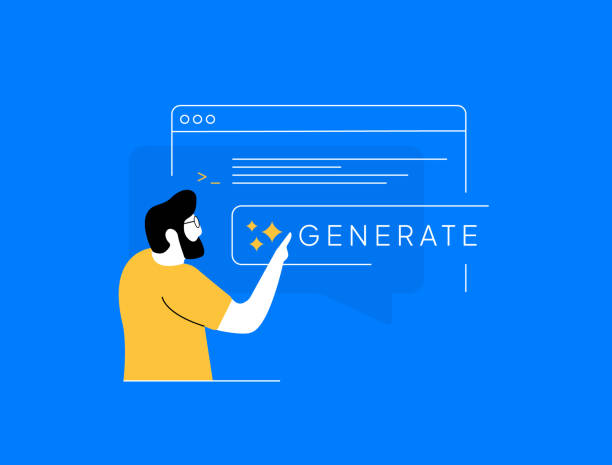
In the world of web, the phrase “Content is King” is an undeniable truth.
Even with a flawless professional website design, without high-quality and engaging content, your website will not be able to attract and retain an audience.
Content not only engages users but also plays a vital role in SEO and your website’s ranking in search engines.
But how can engaging content be produced? The first step is knowing your target audience.
Who are they? What are their needs, interests, and pain points? By answering these questions, you can produce content that directly connects with them.
Second, don’t forget content format diversity.
Don’t just stick to text.
Videos, infographics, podcasts, high-quality images, and even GIFs can make your content more entertaining and digestible.
For example, a complex technical explanation can be presented much more engagingly in the form of an infographic.
Third, create value.
Your content should answer users’ questions, solve their problems, or provide new information.
Purely promotional content is usually not well-received.
Instead of just selling products, educate, guide, and entertain your audience.
Fourth, consider consistency and up-to-dateness.
Regularly add new content and keep old content updated.
An active and content-rich blog can continuously drive new traffic to your website and show search engines that your website is alive and dynamic.
Fifth, don’t forget SEO optimization.
Smart use of keywords, engaging titles, and meta descriptions helps search engines better understand your content and, consequently, display it to the right audience.
Producing engaging content is an ongoing process and is considered a significant part of the long-term strategy of any professional website design.
Security and Maintenance of a Professional Website After Launch
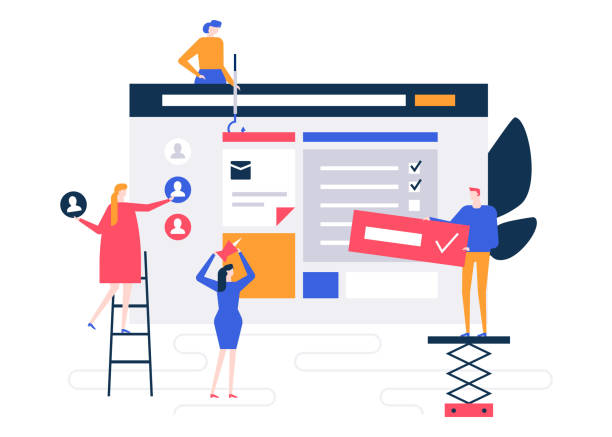
After completing professional website design and launching it, your work is not finished.
In fact, this is the beginning of a new and vital phase called website maintenance and security.
A website without regular maintenance and strong security measures can easily be exposed to cyber attacks, slow down, or even become completely inaccessible.
These issues not only damage your brand’s reputation but can also lead to the loss of sensitive data and, ultimately, significant financial losses.
Regular updates of the Content Management System (CMS), plugins, and website themes are the first and most important step in maintaining security.
Developers continuously release security patches to address vulnerabilities, and failure to update can make your website vulnerable to attacks.
Regular backups of all website data and files are also of paramount importance.
In case of any serious issue, data loss, or cyber attack, these backups can help you quickly restore your website.
Using an SSL certificate (HTTPS) for data encryption and protecting user information, especially on websites with financial transactions, is a necessity.
Furthermore, installing and configuring a Web Application Firewall (WAF) and malware scanning tools can provide additional layers of security.
Continuous monitoring of website performance, loading speed, and server health is also essential to ensure an optimal user experience and early detection of potential issues.
These measures also include checking for broken links, optimizing the database, and compressing images to improve speed.
A professional website requires professional maintenance to remain efficient and secure in the long term and help achieve your business goals.
Investing in maintenance and security services is, in fact, preventing much higher costs in the future and guarantees the stable performance of your professional website.
| Section | Security Action | Maintenance Action |
|---|---|---|
| Software | Update CMS, plugins, and themes to the latest version | Check plugin compatibility and fix potential errors |
| Data | Regular backup (daily/weekly) of database and files | Optimize and clean database |
| Connections | Use SSL/HTTPS certificate | Monitor uptime and server response time |
| Monitoring | Install Firewall (WAF) and malware scanning tool | Check for broken links and 404 errors |
| Performance | Strengthen passwords and limit access to admin panel | Optimize images and media files |
Exploring New Trends in Professional Website Design
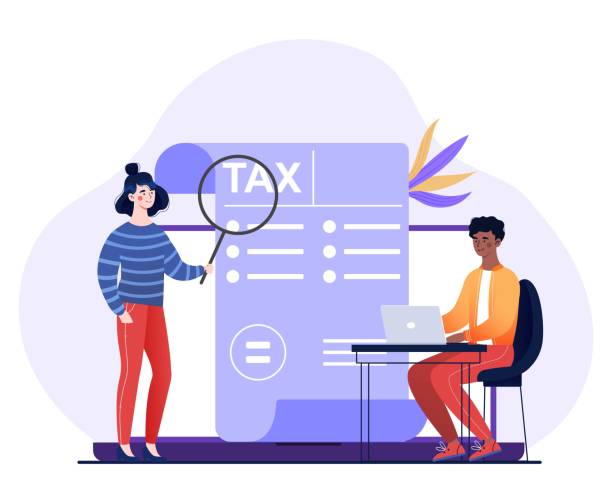
The world of professional website design is constantly evolving and changing.
What is considered a trend today might be obsolete tomorrow.
Therefore, to stay at the forefront of competition and provide a modern and engaging user experience, it is essential to follow and integrate new trends.
One of the most important trends is minimalist design and whitespace.
By reducing unnecessary elements, the focus on main content increases, and the user experience becomes simpler and more pleasant.
This approach has gained significant importance, especially given the large volume of information users encounter daily.
Prominent and creative typography is also emerging as a powerful visual element.
Fonts are no longer just a means of conveying text; they are considered part of the website’s artistic design and can reinforce brand identity.
Animations and micro-animations are also used to add dynamism and interaction to websites.
These small animations can play a role in guiding the user, providing visual feedback, and adding an entertaining element to the overall experience.
With the increasing use of mobile devices, Responsive Design, which adapts the website to any screen size, is no longer an option but a necessity.
Additionally, Dark Mode has gained increasing popularity due to reducing eye strain for users and consuming less battery.
Technically, the integration of Artificial Intelligence (AI) and Machine Learning (ML) to provide more personalized experiences, intelligent chatbots, and user data analysis, shapes the future of professional website design.
3D design and Augmented Reality (AR) are also finding their place in interactive websites, especially for product displays.
Furthermore, a focus on super-fast loading speed and optimizing website performance for search engines and users will always remain a core and fundamental trend.
Following and implementing these trends can help you create a professional and modern website design.
Is your company’s website as professional and trustworthy as it should be? With specialized corporate website design by RasaWeb, create an online presence that reflects your credibility and attracts more customers.
✅ Build a powerful and professional image for your brand
✅ Convert visitors into real customers
⚡ Get a free consultation now!
Challenges and Solutions in Professional Website Design
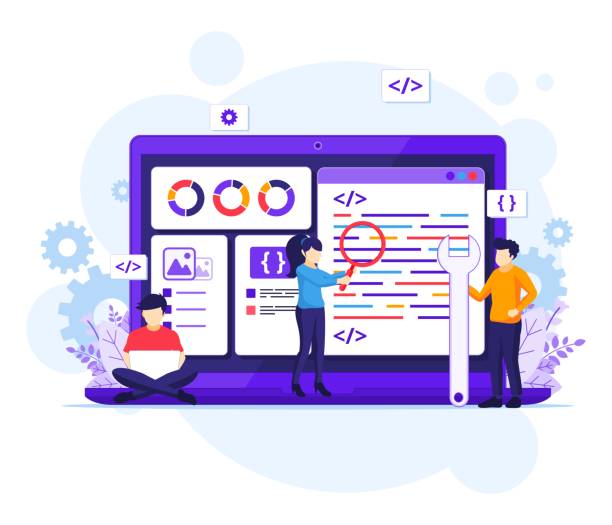
The path of professional website design, while bringing very positive results, is not without challenges.
Understanding these challenges and preparing appropriate solutions for them can significantly contribute to the success of your project.
One common challenge is budget and time constraints.
Website design projects can be expensive and time-consuming, especially if complex features or specific customizations are desired.
The solution to this challenge is meticulous planning, prioritizing features, and using flexible platforms like CMSs that can accelerate development.
Furthermore, transparency in negotiations with the design team and setting realistic expectations from the outset are crucial.
Another challenge is choosing the right design team.
The market is full of web design agencies and freelancers, and choosing a team that can accurately implement your vision is difficult.
The solution is to carefully review their portfolios, speak with their previous clients, and ensure their expertise in your industry. The next challenge is producing high-quality content and keeping it updated.
Many businesses launch their websites but face difficulties in continuously producing engaging content for them.
The solution to this challenge is to develop a comprehensive content strategy from the outset, hire professional writers, and allocate sufficient resources for this section.
Also, security and maintenance issues after launch are a significant challenge.
Websites are constant targets of cyberattacks, and lack of updates and monitoring can be disastrous.
The solution is to ensure, from the very beginning, with a support and maintenance agreement with the design team or a web security specialist, that your website will always be secure and up-to-date. By considering these challenges and implementing appropriate solutions, you can experience a successful professional website design.
The Future of Professional Website Design and Final Tips
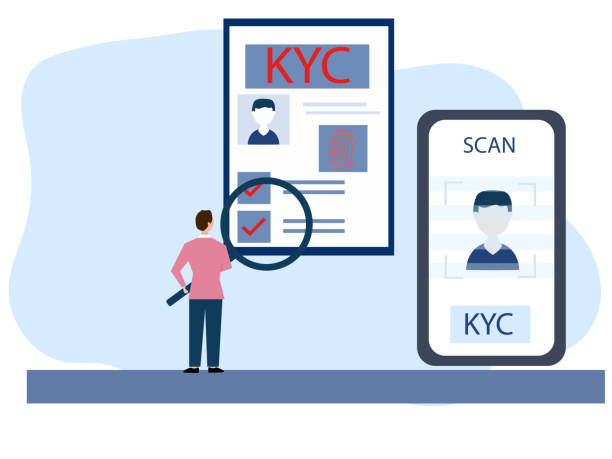
The future of professional website design is moving towards highly personalized, interactive, and immersive user experiences.
With the advancement of technologies like Artificial Intelligence (AI) and Blockchain, websites are expected to move beyond static platforms and become dynamic and intelligent ecosystems.
Web 3.0 and the Metaverse are concepts opening new horizons for online interactions, where websites can offer 3D and virtual reality experiences.
Voice and visual search are also becoming increasingly widespread, requiring designers to optimize websites for these types of interactions as well.
Also, focusing on Accessibility for people with disabilities will become a crucial aspect of professional website design to ensure no user is deprived of the online experience.
In conclusion, it can be said that professional website design is not an expense, but a strategic investment.
A successful website is the result of the collaborative effort of a specialized team that pays attention to details and utilizes the latest standards and technologies.
To ensure success, always strive for the best, from precise needs assessment to continuous launch and maintenance.
With a comprehensive and forward-looking approach, your website can become a powerful tool for the growth and development of your business in the digital world.
Remember that your website is the first point of contact for many customers with your brand, so ensure this first impression is exceptional and professional.
By considering these points, you can take steps towards developing an advanced and efficient website.
Frequently Asked Questions
| Question | Answer |
|---|---|
| What does professional website design mean? | Professional website design refers to creating a user-friendly, visually appealing, fast, secure, and search engine-optimized website that meets business objectives. |
| What are the most important features of a professional website? | Responsiveness, high speed, security, SEO-friendliness, excellent User Experience (UX) and User Interface (UI), high-quality content, and strong branding. |
| Why is responsive design crucial for a professional website? | Responsive design ensures that your website is displayed correctly on any device (computer, tablet, mobile), which is crucial for user experience and Google ranking. |
| What is the role of UI and UX in professional website design? | UX (User Experience) focuses on ease of use and user satisfaction, while UI (User Interface) deals with the visual appearance and user interaction with the website. Both are essential for attracting and retaining an audience. |
| What is the role of SEO in professional website design? | SEO is a cornerstone. A professional website must have a strong technical structure, optimized content, and high speed to achieve a good ranking in search engine results and gain visibility. |
| What tools or platforms can be used for professional website design? | Content management platforms like WordPress, Joomla, or Drupal; web development frameworks like React, Angular, or Vue.js; and graphic design tools like Figma or Adobe XD. |
| What are the main stages of professional website design? | Planning and research, wireframe and mockup design, development and coding, content entry, testing and review, and finally launch and maintenance. |
| What is the importance of security in a professional website? | Website security is crucial for protecting user information and business credibility. Using SSL/TLS, firewalls, regular backups, and updates are vital measures. |
| Does a professional website require maintenance after launch? | Yes, regular maintenance including software updates, checking for broken links, performance monitoring, backups, and adding fresh content is essential to maintain website efficiency and ranking. |
| What distinguishes a professional website from an amateur one? | A professional website focuses on business objectives, provides an exceptional user experience, adheres to high technical standards, and is continuously optimized for improvement, whereas an amateur website typically lacks these features. |
And other services of RasaWeb Advertising Agency in the field of advertising
Smart Content Strategy: A dedicated service for growth in customer acquisition based on key page optimization.
Smart Website Development: A dedicated service for growth in click-through rates based on marketing automation.
Smart Sales Automation: An innovative service for increasing website traffic through marketing automation.
Smart Google Ads: A professional solution for improving SEO ranking with a focus on marketing automation.
Smart Direct Marketing: A blend of creativity and technology for campaign management through custom programming.
And over hundreds of other services in the field of online advertising, advertising consulting, and organizational solutions
Online Advertising | Advertising Strategy | Advertorial
Resources
Website Optimization Principles for Search Engines
Fundamentals of User Interface and User Experience Design
Content Marketing Strategy for Websites
Key Tips for Enhancing Website Security
✅ With Rasaweb Afarin Digital Marketing Agency, transform your business in the digital world and achieve your big goals. We pave your way to success by providing services such as professional website design, SEO, and content marketing.
📍 Tehran, Mirdamad Street, next to Bank Markazi, Southern Kazeroon Alley, Ramin Alley, No. 6

